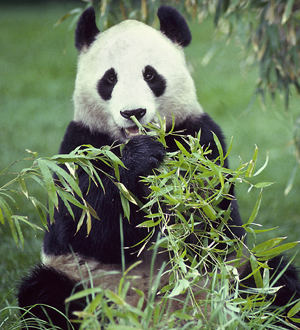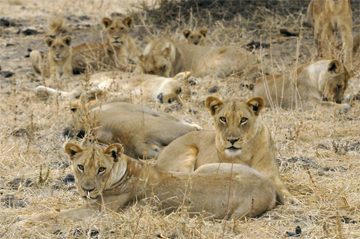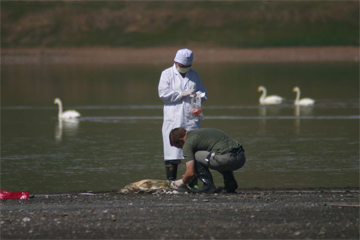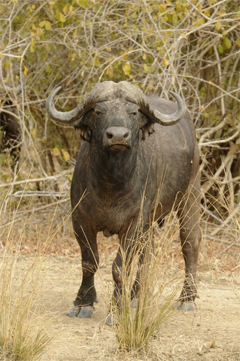Climate change may trigger spread of disease from animals to people
Jeremy Hance, mongabay.com
October 7, 2008
The Deadly Dozen: diseases most likely to spread due to climate change
|
|
Wildlife Conservation Society (WCS) experts have released a report warning of 12 "zoonotic" or animal-linked diseases that are likely to spread due to climate change. Released today at the IUCN World Conservation Congress in Barcelona the report, entitled "The Deadly Dozen: Wildlife Diseases in the Age of Climate Change", argues for preliminary action and research to keep ahead of spreading disease.
The impact of climate change on global diseases has been largely drowned out by news of diminishing glaciers, cannibalizing polar bears, and conflicts due to drought. Dr. Steven Sanderson, President and CEO of WCS, points out that "the term 'climate change' conjures images of melting ice caps and rising sea levels… but just as important is how increasing temperatures and fluctuating precipitation levels will change the distribution of dangerous pathogens."
The list of a dozen pathogens includes some infamous diseases, like bird flu and Ebola, while others are little known outside of the region in which they occur (see below). The researchers believe that the best way to stay on top of the diseases is continual monitoring of wildlife health in risk areas.
 Parasites and pandas: As temperatures and precipitation levels shift, the number of parasites such as nematodes will increase in many places. The nematode Baylisascaris procyonis is spread by the common raccoon and is deadly to many other species of wildlife and humans, and one species—Baylisascaris schroederi—causes death in its natural host: the Critically Endangered giant panda. (Photo credit: Dennis DeMello © Wildlife Conservation Society) |
"The health of wild animals is tightly linked to the ecosystems in which they live and influenced by the environment surrounding them, and even minor disturbances can have far reaching consequences on what diseases they might encounter and transmit as climate changes. Monitoring wildlife health will help us predict where those trouble spots will occur and plan how to prepare," says Sanderson.
In addition, monitoring of wildlife health can grant greater insight our knowledge of environmental changes. Dr. William Karesh, director of WCS's Global Health Programs, describes wildlife health monitoring as "a new lens to see what is changing around us and will help governments, agencies, and communities detect and mitigate threats before they become disasters."
If an outbreak becomes a 'disaster', as Karesh described it, the incident could affect more than just immediate human and wildlife populations. Past outbreaks have caused significant economic damage. It is estimated that livestock diseases alone have caused $100 billion in losses for the global economy since the mid-1990s.
The Wildlife Conservation Society's "Deadly Dozen"
 Lions and Babesia: Climate factors have fostered heavy infestations of ticks—and the Babesia diseases they carry—on wild buffalo and subsequent spill-over infection of lions. The tick-borne pathogens render lions more susceptible to canine distemper, which has resulted in large die-offs of lions in East Africa. (Photo credit: Julie Larsen Maher © Wildlife Conservation Society) |
The "Deadly Dozen" are diseases that WCS has identified as likely to spread due to climate change. The report stresses that the list is not complete, nor is their any certainty that these disease will in fact spread.
1. Babesiosis: This disease is tick-borne, affecting both wildlife and human populations. The disease, not fatal in itself, causes greater susceptibility to other infections. For example, after dry conditions spawned a heavy infestation of ticks in East Africa, large numbers of lions died from canine distemper after first being weakened by Babesiosis. The disease is becoming more common in Europe and North America, also in relation with shifting tick distributions.
2. Bird flu: Changes in climate may disrupt natural movements and migrations of wild birds, possibly bringing them into contact with greater numbers of domestic birds, thereby further spreading bird flu. A particular pathogenic strain of bird flu, labeled H5NI, can be contracted by humans. This strain has caused grave concern among medical experts who worry it will evolve to become contagious from human to human.
3. Bovine tuberculosis: As cattle move globally, so does bovine tuberculosis. As climate change affects water availability worldwide, it is reasonable to assume that cattle distribution will change, bringing bovine tuberculosis to new regions. The disease can spread from cattle to wildlife and humans, greatly affecting natural environments and human settlements.
 Monitoring for avian influenza: Wildlife health will serve as an important early warning system for climate-related changes in a wide range of pathogens, including potential pandemics such as avian influenza. Wildlife veterinarians working for the Wildlife Conservation Society are shown here collecting samples from whooper swans in Mongolia as part of GAINS, a consortium of organizations that monitor wild bird populations worldwide. (Photo credit: © W. Karesh) |
4. Cholera: This is a deadly water-borne disease that currently affects a large number of people in the developing world. Rising global temperatures will likely spread the disease, since it has been shown that higher water temperatures cause greater occurrence of the bacteria which leads to cholera.
5. Ebola: A deadly virus that targets people, gorillas, and chimpanzees. There is no known cure. The virus appears to be linked to variations in precipitation, leading experts to believe that changing climate will allow outbreaks in new locations.
6. Parasites: Widespread, parasites are expected to shift ranges with temperature and precipitation changes. Some parasites affect many species, including humans. Others, like the Baylisascaris schroederi, are fatal only to one species, in this case the giant panda. A study from last year showed that 50 percent of panda mortalities in the past five years were due to the parasite.
7. Lyme disease: Like Babesiosis, Lyme disease is tick-borne. Where climate change shifts tick populations, the disease will follow. The disease can cause grave illness to humans who have been bitten by carrier ticks.
8: The plague: Infamous due to its ravages across Europe in the 14th Century, the plague still causes mortality in wildlife, domestic animals, and even humans. Spread by fleas carried from place-to-place by rodents. As climate changes, rodent populations are expected to shift worldwide perhaps bringing the plague to new regions.
 African buffalo and bovine tuberculosis: Climate change impacts on water availability due to drought are likely to increase the contact of livestock and species such as the African buffalo at limited water sources, resulting in a potential increase in the transmission of bovine tuberculosis between animal populations that can impact both tourism and food production. (Photo credit: Julie Larsen Maher © Wildlife Conservation Society) |
9. Red Tides: Algal blooms are increasing worldwide. Such blooms create toxins dangerous to marine wildlife and humans. Called 'red tides' the toxins have been known to kill penguins, seabirds, while causing massive fish mortality, which has environmental as well as economic consequence. Humans have also been known to become ill from ingesting the toxins. As temperatures in the sea change, it is believed that red tides will become only more prevalent.
10. Rift Valley Fever: This fever is having great impact in the Middle East and Africa on both livestock and people. Infected livestock have high abortion and death rates. In addition, the disease is often fatal to humans. Mosquitoes transmit the disease and as water increases in some areas and lessens in others, there is little question that the range of the disease will change.
11. Sleeping sickness: Transmitted by the tsetse fly, this disease affects both humans and animals. Sleeping sickness is known in 36 countries in Sub-Saharan Africa and leads to 40,000 human deaths every year. The tsetse fly's habitat may shift, like mosquitoes' and ticks', due to climate change.
12. Yellow Fever: Like Rift Valley Fever, Yellow Fever depends on mosquitoes for transportation. As mosquitoes shift due to changes in water availability, it is likely that Yellow Fever will appear in new places. The fever affects primates as well as humans. Recently, Brazil and Argentina have seen sudden drops in primate populations due to Yellow Fever.